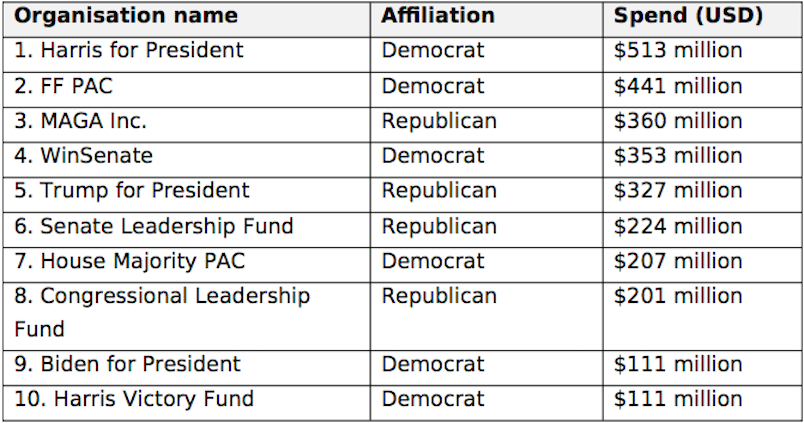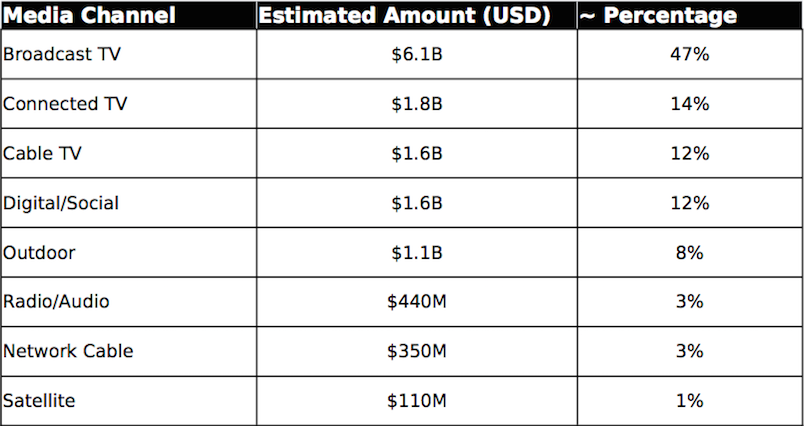Big bucks and bold moves in US election advertising… and spare a thought for the overwhelmed Pennsylvanians
Between US$12 to $15 billion was spent on advertising in this election, $1.2bn in Pennsylvania alone. Sayers Group's Justin Papps breaks down who spent what, where, the key differences in strategies and execution – and takeouts for marketers as the world wakes up to a second Trump presidency.
While the US wakes up to a second term from President Trump, from a purely advertising perspective it is clear that the 2024 US election has been like no other. Depending who you ask, between US$12 to $15 billion was spent on advertising in this election – approximately 33 per cent more than the 2020 election cycle.
The numbers beggar belief when you dig deep into them to see that $1.2 billion was spent in Pennsylvania alone (three times the 2020 spend), and seven battleground states accounted for nearly 80 per cent of the campaign dollars.
Unsurprisingly, the residents of these states report being exhausted by the onslaught, with their favourite shows reportedly having up to five political ads per break.
Importantly, it was not just the Trump and Harris campaigns spending money. Spending on the Senate and the House also accounted for a significant proportion nationally, as did the private entities.
Given the outcome, it is interesting to note even in the table below that the Democrats had a 60:40 spend advantage over the Republicans.
According to NPR the top ten spenders were:
Pic: NPR.com
By way of comparison, the total spend in Australia across the ALP, Coalition and UAP for the whole 2022 election would have come in 6th on this list at approximately US$277 million or AU$418 million.
A record-breaking year and a boost for broadcast TV
According to the Myers Report, we can see where the dollars went and just how hard both parties ran to secure every possible vote. Bucking the trend we see in other markets, broadcast or FTA TV took out almost half the spend, jumping to roughly 60 per cent when you add in cable TV.
You can imagine the local ad sales directors at KYW-TV (CBS) and WPVI-TV (ABC) in Pennsylvania will be enjoying the massive boost to their coffers, even if local advertisers may lament losing their ad spots to the big spending political parties in the last few months.
It could be argued that the large rural constituency accounted for some of this broadcast TV spend, and it will be interesting to see, once the dust settles, what proportion of this war-chest was directed to local stations and affiliates addressing local issues.

Pic: The Myers Report
Digital advertising (which also incorporated connected TV in most reports) allowed for micro-targeting, with estimates carrying between $2.5 to $4 billion depending what you include. Irrespective of the final number – which will become clearer in coming weeks – Meta, TikTok and YouTube have shown their influence with short form video content as an impact driver and shaper of opinions… or potentially reinforcer of red or blue biases.
Pennsylvania: The ultimate swing state
Pennsylvania has always been a hotly contested state, known for its diverse demographics spanning urban, suburban, and rural communities. The combination of macro issues and micro localised issues drove a massive push over the course of the election, with over $1.2 billion being ploughed into the state during the campaign.
Democratic strategy in Pennsylvania
The Democrats believed that winning Pennsylvania required both a media blitz and a grassroots approach, targeting key groups such as women, young people, and suburban families:
- Ads targeting women: Democrats spent millions on TV and digital ads specifically aimed at female voters, with messages like “it’s okay to vote your values, not just your family’s.” The campaign encouraged women to vote independently, acknowledging that they might feel different from their household on key issues.
- Targeted digital campaigns for younger voters: Knowing young people lean Democrat, the party invested heavily in TikTok and Instagram ads. They also leveraged celebrities, and used humour and memes, such as reminders to “vote like your future depends on it,” to engage these voters in a way that felt relevant and relatable.
- In-person canvassing and voter registration drives: Beyond ads, Democrats organised extensive in-person efforts. In key Pennsylvanian cities like Philadelphia and Pittsburgh, they set up voter registration booths and conducted door-to-door canvassing, especially in areas with a large concentration of young voters and minority communities.
- Get-out-the-vote concerts: Democrats hosted events like mini-concerts and local gatherings near college campuses, combining entertainment with voting reminders. These events were designed to encourage turnout among young Pennsylvanians, although some questions have been raised about the final concert held by the Democrats featuring the likes of Beyoncé and Jon Bon Jovi as a “gathering of elites”, notwithstanding much of it was pitched as a thank you for volunteers.
Republican strategy in Pennsylvania
The Republicans approached Pennsylvania with a different set of tactics, focusing on concerns they identified as resonating with Pennsylvanians, such as the economy and local business support:
- Economic-focused advertising: Republicans spent millions on ads emphasising jobs, economic growth, and energy independence – topics that resonated with Pennsylvania’s blue-collar workers and rural voters. These ads frequently appeared on local TV channels, where they could reach Pennsylvanians of all ages.
- Rural outreach and local events: Instead of just relying on ads, Republicans invested in on-the-ground events across Pennsylvania’s rural areas. They held community gatherings, job fairs, and discussions about how Republican policies would support local industries, including the coal and gas sectors, which are significant employers in the state.
- Text and direct mail targeting suburban households: Republicans used personalised texts and direct mail to reach suburban voters, focusing on education and family values. Messages centred around parental rights in schools and community safety, which they hoped would resonate with suburban families, a crucial demographic in Pennsylvania’s swing districts.
- Faith-based and veterans’ outreach: Republicans also leaned heavily into grassroots tactics with faith-based communities and veterans’ organisations, volunteer-led discussions and organising town halls. They collaborated with local churches and veterans’ groups to mobilise voters and make voting accessible in every community.
Key takeaways from Pennsylvania
Pennsylvania was a case study in how diverse strategies can shape a campaign, combining big ad spends with hands-on community efforts. Deep pockets were clearly never going to be enough on their own – just ask the Democrats who spent $673 million to the Republicans $543 million in the State. And don’t skim over those numbers – that is $130 million difference. That is a lot of additional airtime, billboards and social posts.
As the marketing mix modellers dissect the spend to see what worked and what didn’t, pollsters will also need to look at their predictions and ask themselves that perennial question as to whether people tell the truth when asked who they will vote for, or whether the only time they are truly truthful is when they have a pencil in hand in the privacy of the voting booth.
There are a few important takeaways from the marketing approach of both parties in Pennsylvania:
- Spend strategically across all platforms – but know when you're contributing to the static: Both parties invested heavily in digital ads for younger audiences while doubling down on traditional TV ads for older voters – particularly in regional areas. Out-of-home also clearly played its role, allowing for localised messages for local candidates. Both parties really had little choice in this multi-platform approach given the diverse demographics and geographic priorities, but it ended up being an inescapable onslaught for all residents. At what point was it all too much and it became annoying noise for residents just wishing the election would be over?
- Go beyond ads – engage on the ground: The importance of non-advertising tactics, such as canvassing and community events, cannot be underestimated and clearly played a major role in the outcome. Even in the digital age, a personal touch makes a significant impact, especially in close competitions. Door knocking and phone calls were a key feature of the campaign to support the ad spend, literally seeking out votes one at a time in the State.
- Customise messages for local values: Each party took a tailored approach in Pennsylvania, addressing the state’s economic and social concerns. Knowing your audience’s specific priorities can make any campaign more relevant and resonant, particularly when it is in their own backyard. What is happening in overseas theatres of conflict, or even across State lines, is often less important than what is happening in the local community.
Finally, you might be wondering which specific ads got the most airtime, with thousands of localised versions created across the campaign. According to NPR, for the Harris campaign, over $19 million was put behind this ad focussed on contrasting economic policy, whereas the Trump campaign spent the most behind this single ad about ending taxes on social security and tips.
While the party officials, lobbyists, pollsters, donor groups and pundits dissect what went wrong or right, depending on which side of the fence they sit, it is indisputable that the clear winners were the media companies, and particularly the broadcasters with unprecedented inflows of revenue over the course of the campaign.
Whether the same tactics are employed when the circus runs again in 2028 is yet to be seen, but it is clear that new benchmarks have been set that need thorough analysis to understand what worked and what was wasted. Irrespective of who they voted for, it is safe to assume that all Pennsylvanians will be united on one thing – that they will take great delight that they can finally enjoy an episode of Jeopardy or The Price is Right without being smacked in the face by political ads in every spot in every break.
You can hear the muted sighs of relief from here.



